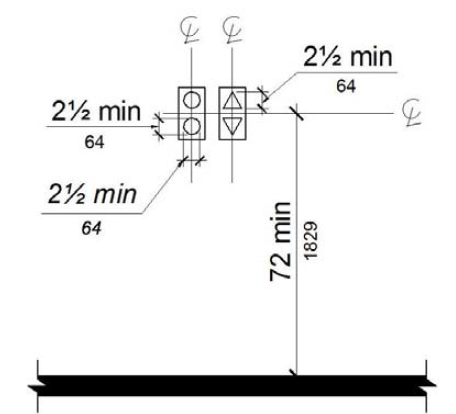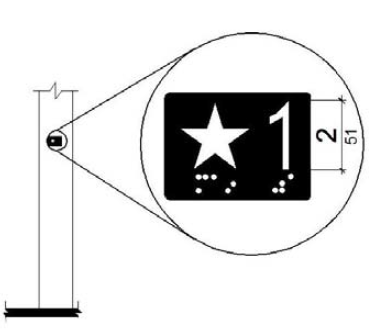2016 California Standards for Accessible Design Pocket Guide - Eff. Jan. 1, 2017
11B-407.2 Elevator landing requirements.
Elevator landings shall comply with Section 11B-407.2.
11B-407.2.1 Call controls.
Where elevator call buttons or keypads are provided, they shall comply with Sections 11B-407.2.1 and 11B-309.4 _|Operation|_.
[2010 ADAS] 407.2.1 Call Controls. Where elevator call buttons or keypads are provided, they shall comply with 407.2.1 and 309.4. Call buttons shall be raised or flush.
Exception: Reserved.
[2010 ADAS] EXCEPTION: Existing elevators shall be permitted to have recessed call buttons.
11B-407.2.1.1 Height.
Call buttons and keypads shall be located within one of the reach ranges specified in Section 11B-308, measured to the centerline of the highest operable part.
Exception: Reserved.
[2010 ADAS] EXCEPTION: Existing call buttons and existing keypads shall be permitted to be located at 54 inches (1370 mm) maximum above the finish floor, measured to the centerline of the highest operable part.
11B-407.2.1.2 Size and shape.
Call buttons shall have square shoulders, be ¾ inch (19.1 mm) minimum in the smallest dimension and shall be raised 1/8 inch (3.2 mm) plus or minus 1/32 inch (0.8 mm) above the surrounding surface. The buttons shall be activated by a mechanical motion that is detectable.
[2010 ADAS] 407.2.1.2 Size. Call buttons shall be ¾ inch (19 mm) minimum in the smallest dimension.
Exception: Reserved.
[2010 ADAS] EXCEPTION: Existing elevator call buttons shall not be required to comply with 407.2.1.2.
11B-407.2.1.3 Clear floor or ground space.
A clear floor or ground space complying with Section 11B-305 shall be provided at call controls.
[2010 ADAS] Advisory 407.2.1.3 Clear Floor or Ground Space. The clear floor or ground space required at elevator call buttons must remain free of obstructions including ashtrays, plants, and other decorative elements that prevent wheelchair users and others from reaching the call buttons. The height of the clear floor or ground space is considered to be a volume from the floor to 80 inches (2030 mm) above the floor. Recessed ashtrays should not be placed near elevator call buttons so that persons who are blind or visually impaired do not inadvertently contact them or their contents as they reach for the call buttons.
11B-407.2.1.4 Location.
The call button that designates the up direction shall be located above the call button that designates the down direction.
Exception: Reserved.
[2010 ADAS] Advisory 407.2.1.4 Location Exception. A destination-oriented elevator system provides lobby controls enabling passengers to select floor stops, lobby indicators designating which elevator to use, and a car indicator designating the floors at which the car will stop. Responding cars are programmed for maximum efficiency by reducing the number of stops any passenger experiences.
11B-407.2.1.5 Signals.
Call buttons shall have visible signals that will activate when each call is registered and will extinguish when each call is answered. Call buttons shall be internally illuminated with a white light over the entire surface of the button.
[2010 ADAS] 407.2.1.5 Signals. Call buttons shall have visible signals to indicate when each call is registered and when each call is answered.
Exceptions:
1. Reserved.
2. Reserved.
[2010 ADAS] 2. Existing elevators shall not be required to comply with 407.2.1.5.
11B-407.2.1.6 Keypads.
Where keypads are provided, keypads shall be in a standard telephone keypad arrangement and shall comply with Section 11B-407.4.7.2.
ETA Editor's Note
Lacking certain Exceptions allowed by 2010 ADAS, and imposing additional requirements regarding call buttons, the preceding CBC requirements pertaining to elevator call controls are more stringent than 2010 ADAS.
11B-407.2.2 Hall signals.
Hall signals, including in-car signals, shall comply with Section 11B-407.2.2.
11B-407.2.2.1 Visible and audible signals.
A visible and audible signal shall be provided at each hoistway entrance to indicate which car is answering a call and the car’s direction of travel. Where in-car signals are provided, they shall be visible from the floor area adjacent to the hall call buttons.
Exceptions:
1. Reserved.
2. Reserved.
[2010 ADAS] 2. In existing elevators, a signal indicating the direction of car travel shall not be required.
11B-407.2.2.2 Visible signals.
Visible signal fixtures shall be centered at 72 inches (1829 mm) minimum above the finish floor or ground. The visible signal elements shall be a minimum 2½ inches (64 mm) high by 2½ inches (64 mm) wide. Signals shall be visible from the floor area adjacent to the hall call button.
Exceptions:
1. Reserved.
2. Reserved.
[2010 ADAS] 2. Existing elevators shall not be required to comply with 407.2.2.2.

FIGURE 11B-407.2.2.2 ‡‡
VISIBLE HALL SIGNALS
11B-407.2.2.3 Audible signals.
Audible signals shall sound once for the up direction and twice for the down direction, or shall have verbal annunciators that indicate the direction of elevator car travel. Audible signals shall have a frequency of 1500 Hz maximum. Verbal annunciators shall have a frequency of 300 Hz minimum and 3000 Hz maximum. The audible signal and verbal annunciator shall be 10 dB minimum above ambient, but shall not exceed 80 dB, measured at the hall call button.
Exceptions:
1. Reserved.
2. Reserved.
[2010 ADAS] 2. Existing elevators shall not be required to comply with the requirements for frequency and dB range of audible signals.
11B-407.2.2.4 Differentiation.
Reserved.
ETA Editor's Note
Lacking certain Exceptions allowed by 2010 ADAS, and imposing additional requirements regarding visible signals, the preceding CBC requirements pertaining to elevator hall signals are more stringent than 2010 ADAS.
11B-407.2.3 Hoistway signs.
Signs at elevator hoistways shall comply with Section 11B-407.2.3.
11B-407.2.3.1 Floor designation.
Floor designations complying with Sections 11B-703.2 and 11B-703.4.1 shall be provided on both jambs of elevator hoistway entrances. Floor designations shall be provided in both raised characters and braille. Raised characters shall be 2 inches (51 mm) high. A raised star, placed to the left of the floor designation, shall be provided on both jambs at the main entry level. The outside diameter of the star shall be 2 inches (51 mm) and all points shall be of equal length. Raised characters, including the star, shall be white on a black background. Braille complying with Section 11B-703.3 shall be placed below the corresponding raised characters and the star. The Braille translation for the star shall be “MAIN”. Applied plates are acceptable if they are permanently fixed to the jamb.
[2010 ADAS] 407.2.3.1 Floor Designation. Floor designations complying with 703.2 and 703.4.1 shall be provided on both jambs of elevator hoistway entrances. Floor designations shall be provided in both tactile characters and braille. Tactile characters shall be 2 inches (51 mm) high minimum. A tactile star shall be provided on both jambs at the main entry level.

FIGURE 11B-407.2.3.1 ‡‡
FLOOR DESIGNATIONS ON JAMBS OF ELEVATOR HOISTWAY ENTRANCES
11B-407.2.3.2 Reserved.
ETA Editor's Note
Imposing additional requirements regarding characters and colors, the preceding CBC requirements pertaining to elevator hoistway signs are more stringent than 2010 ADAS.

User Comments/Questions
Add Comment/Question